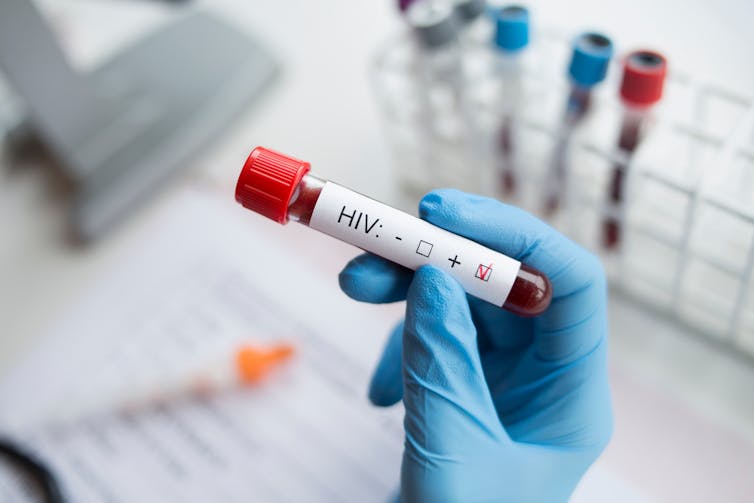
The province of Saskatchewan leads the country in preventable, opportunistic illnesses enabled by poverty. With new changes to income support programs and increased housing instability, things are getting worse.
Saskatchewan has the highest rate of HIV in Canada, with cases more than three times the national average. New cases are occurring via what’s known as vertical transmission (from mother to child), largely unseen in wealthier nations because such cases are preventable with the use of anti-retroviral drugs.
Injection drug use is the most common mode of transmission in the province, and the numbers are highest among Indigenous people where ongoing legacies of colonialism, policy-induced poverty, intergenerational trauma and substance use are woven together.
Indigenous people have met these challenging conditions with resistance, mobilizing Indigenous-led responses to HIV and advancing Indigenous ways of knowing. But these efforts continue to be undermined by limited funding and provincial government failures to provide sufficient income assistance for those living in economic precarity.

Syphilis epidemic
Increasing HIV rates in Saskatchewan are occurring alongside a new epidemic of syphilis.
This is not surprising, because syphilis increases susceptibility to HIV; it’s a harbinger of more HIV infections to come. Syphilis cases are increasing exponentially, to more than 800 cases in 2021, from five cases in 2016. The disease is extremely infectious in its less severe early stages and can, like HIV, be transmitted in pregnancy.
When transmitted in pregnancy (congenital syphilis), syphilis can have dire consequences, including stillbirth and babies born with a range of health issues, among them skeletal and facial anomalies, deafness, blindness and significant neurological problems. In 2016, there were four cases of congenital syphilis in Saskatchewan; four years later there were more than 50.

Both HIV and syphilis are opportunistic infections made more likely by the realities of living in poverty. They are both asymptomatic in their early stages, so people may not know they’re infected. The stress of poverty and substance use can contribute to people engaging in more HIV- and syphilis-risk behaviours than they might otherwise.
Once infected, both syphilis and HIV can be treated, but treatment can be intense — syphilis during pregnancy can require multiple appointments and HIV requires daily medication. When people are living without reliable housing and existing on insufficient income, they have to come up with creative strategies to survive and being screened, tested or treated for new infections is not always a top priority.
Benefits reduced
Inadequate rates of social assistance in Saskatchewan have long contributed to the problem, now exacerbated by changes that have recently reduced the total amount of benefits.
Unlike its predecessor, the new program does not fund the actual cost of utilities, instead providing an insufficient fixed amount. Other supports were reduced or eliminated, such as those for clothing, furniture and school supplies.

The new program also got rid of direct payment to landlords, which previously ensured that no matter what, rent was always paid. These changes have meant that more people than ever are being evicted, with the Saskatchewan Landlord Association reporting that 30 per cent of people on social assistance did not or could not pay their rent in the months after the change took effect.
In November 2021, the Ministry of Social Services stated it would pay rent and utilities directly for recipients who are at risk of homelessness, but housing organizations say this still isn’t happening.
More precarity, fewer resources
The increasing rates of syphilis and HIV are made worse by these changes to income assistance because people have more precarity and fewer resources than previously.
Although pregnant people and new parents often use various strategies to get what they and their children need to get by, their efforts are undermined by a fragmented system of care, lack of culturally responsive services and limited access to existing interventions. That includes screening and testing for asymptomatic, unidentified and/or untreated infections.
Providing adequate rates of social assistance is key to public health. We should need no other reason to ensure people have enough to live on than reducing the rates of entirely preventable, infectious diseases. But it also makes economic sense.
Read more: CERB was luxurious compared to provincial social assistance
The costs of treating people who have contracted these diseases, and particularly children, cost substantially more over time than providing adequate social assistance. Slashing rates of social assistance is a costly mistake and the most marginalized pay the most dearly.
People living in poverty work hard to make ends meet and find creative strategies to make the most out of every dollar, but there is a limit. Without sufficient social assistance to meet people’s basic needs, more people are ending up in precarious circumstances, needing to access to more intensive and long-term interventions.
There is a vicious cycle in Saskatchewan of cutting public funding for social assistance to support people experiencing difficulty, only to intervene when things are much, much worse.
This article is part of research conducted through the Hope Through Strength project, with contributions from Dr. Alexandra King, Sithokozile Maposa, Amanda Froehlich-Chow, Lynette Epp, and Katelyn Roberts. Alana Cattapan receives funding from the Social Sciences and Humanities Research Council of Canada, the Canadian Institutes of Health Research, and the Saskatchewan Health Research Foundation.
Holly Ann McKenzie receives funding from the Canadian Institutes of Health Research and has previously received funding from the Social Sciences and Humanities Research Council of Canada.
This article was originally published on The Conversation. Read the original article.







